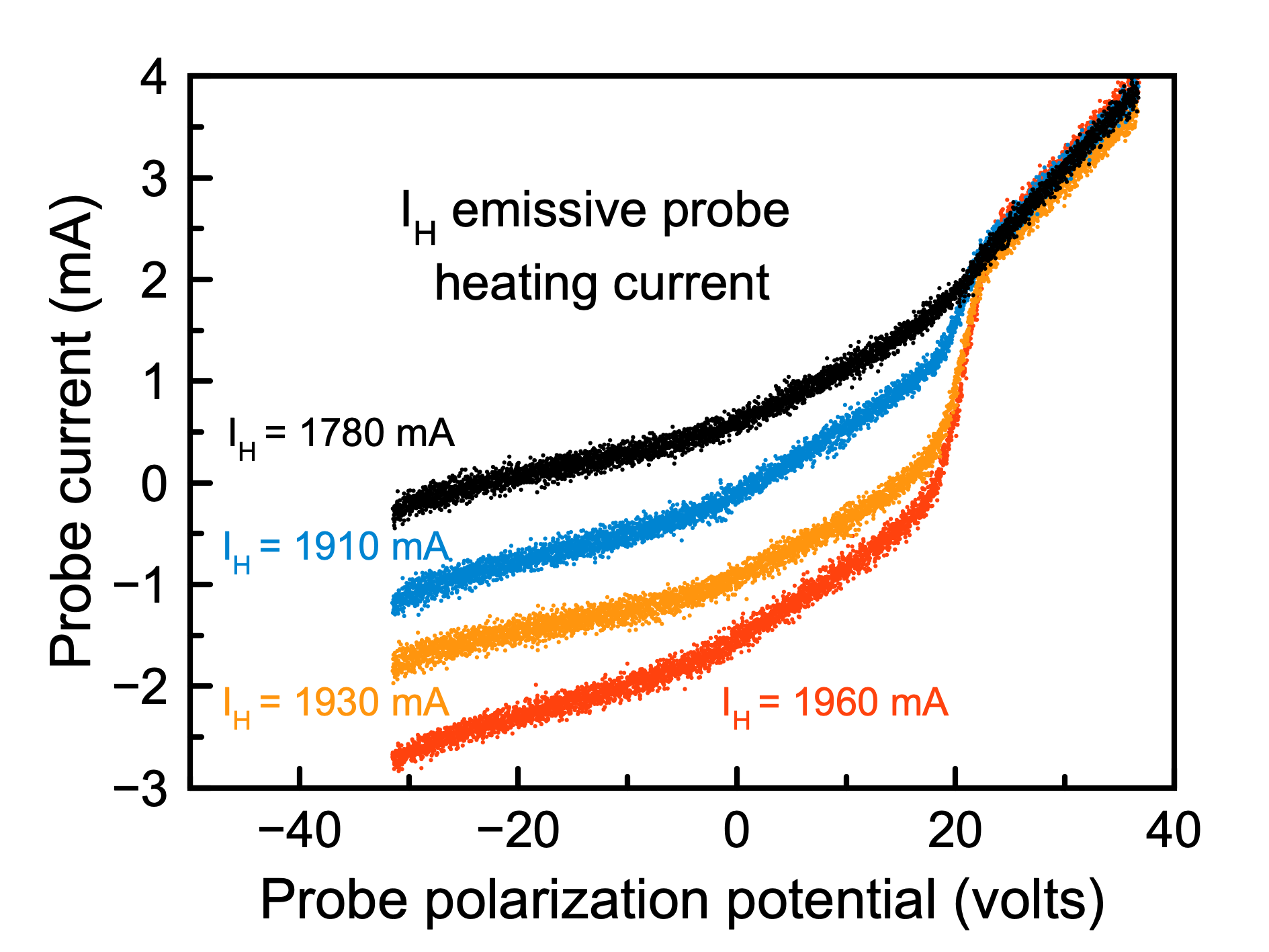Introduction to Langmuir and emissive probe diagnostics
Because of the extent of plasma densities and energies, the experimental techniques to determine its physical properties constitutes a branch of Plasma Physics by itself. In our experiments with cold, low-pressure plasmas essentially we make use of electric probes. One of then is the Langmuir probes which is simply a plasma exposed metallic electrode with a well defined symmetry. This probe is electrically polarized with respect to the plasma and the collected electric current is measured.

The cylindrical Langmir probe can be observed in the photograph at the extreme of a vertical rod inmersed into an Argon plasma. The bright dot is a different diagnostic called emissive probe. and both are electrically connected though a vacuum feedthrough to their external circuits.
Actual measurements with a Langmuir probe are shown in the figure (blue dots) and it may be appreciated that for low voltages (below -20 volts) only a small negative current is collected. The electric potential imposed to the probe was made negative with respect to the plasma, thus leading positive ions to be collected and electrons are repelled. This small negative current is denominated ion saturation current. As the probe bias voltage increases, electrons with energy high enough can reach the probe and are collected. Consequently, the probe current grows. When the polarization potential is further increased the current reverts its sign when crossing the floating potential where ion and electron current are equals.

The electron current increases further as more electrons in the plasma are able to jump the decreasing energy barrier up to the knee located between 0 and 10 volts where the slope changes. At this point the probe potential equals the plasma potential so all electrons can reach the probe.
The kinetic energy of electrons (electron temperature) and number density of electric charges (plasma density) can be determined from the experimental data shown in above figure. When the probe potential becomes negative a the saturation process takes place. The current increments change as no more electrons can be collected. However, for polarization voltages exceeding plasma potential, the probe current still increases because of the imperfect electrical shielding and/or additional physical phenomena.

A fast measuring system was used to obtain the experimental data of these graphs. Recording the full curve lasted 1.78 ms and the delay between two successive curves was of 0.34 ms. In the second figure (red dots) this fast sweeping technique was employed to evidence the superimposed probe current jumps corresponding to disturbances caused by the periodic motion of a group of ions.
The emissive probe is intended for the accurate measurement of the plasma potential. It is usually made of a thin metallic filament heated by an electric current that emits or collects electrons from the plasma according to its electrical polarity. The figure on the right shows the emitted thermionic electron current increases as the probe is hotter as the DC heating current IH increases.

Since the electron emission grows as the probe temperature increases and these electrons are repelled by the probe for voltages below the plasma potential. On the contrary, the electron saturation current remains essentially unchanged as no electrons leave the probe when it is biased over the plasma potential. This fact produce more steeper curves than Langmuir probes allowing a more precise determination of the plasma potential.
A more sophisticated electric probe technique are the different retarded field energy analyzers that are employed to measure energy spectra of ions. In essence, the plasma ions are filtered by a repelling grid, so only those with kinetic energy over a controlled threshold are collected by an electrode.
Interested readers will find additional information in the following references: in:
[1] Principles of plasma diagnostics . I.H. Hutchinson. Cambridge University Press. Chapter 3 (1987).
[2] R.L. Merlino. Understanding Langmuir probe curent-voltage characteristics. Amer. J. Phys.
75, (12), pp. 1078-1085 (2007).
[3] N. Hershkowithz. How Langmuir probes work. Plasma diagnostics. Discharge parameters
and chemistry. O. Auciello and J. Flamm (Eds.). London, Academic Press. pp. 113-183 (1989).
[4] J.P. Sheehan and N. Herskowitz. Emissive probesi>. Plasma Sources Sci. Technol.
20, pp. 1-22 (2011).